Banksia plumosa is a species of shrub that is endemic to Western Australia. It has hairy stems, broadly linear pinnatifid to pinnatipartite leaves with triangular lobes, creamy-yellow flowers in heads of up to eighty, and egg-shaped follicles.
Banksia pseudoplumosa, commonly known as false plumed-banksia, is a species of shrub that is endemic to Western Australia. It has hairy stems, broadly linear, pinnatipartite leaves with sharply-pointed triangular lobes on the sides, yellow flowers in heads of about one hundred, and densely woolly-hairy follicles.
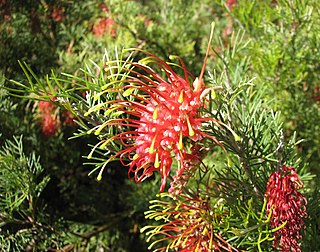
Grevillea thelemanniana, commonly known as spider net grevillea, is species of flowering plant in the family Proteaceae and is endemic to Perth, Western Australia. It is a spreading shrub with linear and pinnatipartite to pinnatisect leaves with linear to narrowly elliptic lobes, and clusters of 6 to 14 pinkish-red and cream-coloured flowers with a red, green-tipped style.
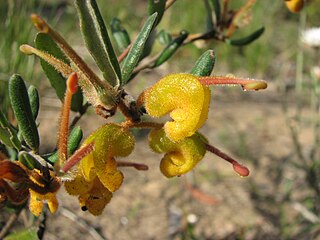
Grevillea chrysophaea, commonly known as golden grevillea, is a species of flowering plant in the family Proteaceae and is endemic to Victoria in Australia. It is a spreading shrub with oblong to almost linear leaves, and dull to golden yellow flowers with a red or orange-red style.

Grevillea obtecta, commonly known as Fryerstown grevillea, Elphinstone grevillea or Taradale grevillea, is a species of flowering plant in the family Proteaceae and is endemic to Victoria in Australia. It is a prostrate, clumping or straggling shrub with pinnatifid, pinnatipartite or toothed leaves, and toothbrush-like clusters of light green to yellowish and purplish to black flowers with a dull yellow to pink style.
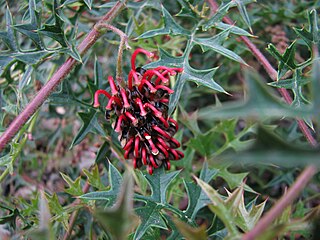
Grevillea montis-cole, commonly known as Mount Cole grevillea, is a species of flowering plant in the family Proteaceae and is endemic to central-western Victoria, Australia. It is a shrub with divided leaves with 5 to 15 lobes, the end lobes more or less triangular to narrowly oblong and sharply-pointed, and clusters of greenish to fawn and dull purplish flowers.

Isopogon ceratophyllus, commonly known as the horny cone-bush or wild Irishman, is a plant of the family Proteaceae that is endemic to the coast in Victoria, South Australia and on the Furneaux Group of islands in Tasmania. It is a small woody shrub that grows to 100 cm high with prickly foliage. It is extremely sensitive to dieback from the pathogen Phytophthora cinnamomi

Grevillea stenomera, commonly known as lace net grevillea, is a species of flowering plant in the family Proteaceae and is endemic to near-coastal areas in the west of Western Australia. It is a rounded, glaucous shrub with pinnatisect leaves with 5 to 15 linear lobes, and pinkish and greenish-yellow flowers with a greenish style.

Adenanthos detmoldii, commonly known as Scott River jugflower or yellow jugflower, is a species of shrub in the family Proteaceae. It is endemic to the south-west of Western Australia.

Adenanthos barbiger, the hairy jugflower or hairy glandflower, is a species of shrub in the family Proteaceae. It is endemic to the south-west of Western Australia. It usually grows to 1 metre high, and has bright red flowers that appear mostly between August and December. The species was first formally described in 1839 by English botanist John Lindley in A sketch of the vegetation of the Swan River colony.
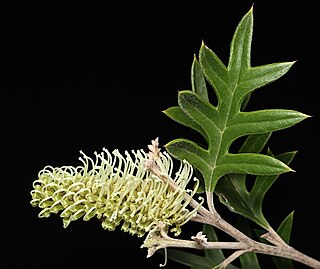
Grevillea willisii, commonly known as Omeo grevillea or rock grevillea, is species of flowering plant in the family Proteaceae, and is endemic to the eastern highlands of Victoria, Australia. It is a spreading to erect shrub with pinnatipartite leaves, the end lobes broadly triangular to oblong and sometimes sharply pointed, and dense clusters of greenish-white to fawn-coloured flowers with a white to cream-coloured style.

Grevillea scapigera, commonly known as Corrigin grevillea, is a species of flowering plant in the family Proteaceae and is endemic to a small area of the south-west of Western Australia. It is a prostrate to weakly ascending, suckering shrub with divided leaves, the end lobes broadly triangular and sharply-pointed, and spikes of white to cream-coloured flowers held above the foliage.

Isopogon trilobus, commonly known as barrel coneflower, is a species of flowering plant in the family Proteaceae and is endemic to South Coast Western Australia. It is a shrub with wedge-shaped leaves with lobed or toothed leaves, and oval, spherical or barrel-shaped heads of cream-coloured to yellow flowers.
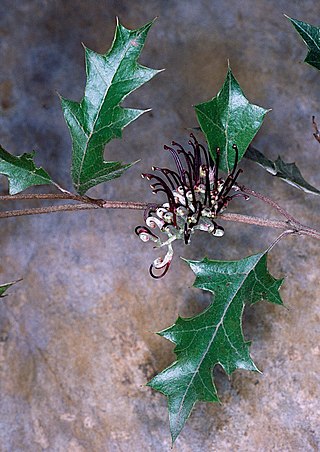
Grevillea scortechinii, commonly known as black grevillea, is a species of flowering plant in the family Proteaceae and is endemic to eastern Australia. It is a prostrate to sprawling shrub with serrated to pinnatifid leaves, the end lobes broadly triangular and often sharply-pointed, and clusters of brown flowers with a dark purplish-black style. There are two subspecies, subsp. scortechinii found in Queensland and subsp. sarmentosa, found in New South Wales.

Grevillea cirsiifolia, commonly known as varied-leaf grevillea, is a species of flowering plant in the family Proteaceae and is endemic to the south-west of Western Australia. It is a prostrate shrub, usually with divided leaves with eight to thirty lobes, and creamy white and bright yellow flowers with a white to pale yellow style.
Grevillea secunda is a species of flowering plant in the family Proteaceae and is endemic to inland Western Australia. It is a spreading shrub with divided leaves, the end lobes cylindrical and sharply pointed, and clusters of pinkish-red flowers with a red style arranged on one side of the floral rachis.
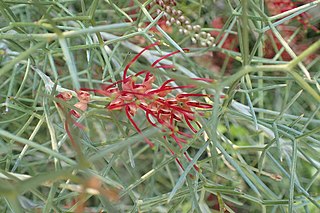
Grevillea squiresiae is a species of flowering plant in the family Proteaceae and is endemic to a small area in the Avon Wheatbelt region of Western Australia. It is a single-stemmed shrub, usually with pinnatipartite leaves, the end lobes more or less linear, and clusters of red flowers.
Grevillea stenostachya is a species of flowering plant in the family Proteaceae and is endemic to the west of Western Australia. It is a compact shrub with pinnatipartite to almost pinnatisect leaves with 3 to 5 lobes, the end lobes cylindrical and sharply pointed, and greenish-white to creamy yellow flowers with a cream-coloured to yellow style.

Grevillea wittweri is a species of flowering plant in the family Proteaceae and is endemic to the southwest of Western Australia. It is a shrub with pinnatipartite leaves, and clusters of greenish to fawn flowers with a crimson style.
Grevillea rubicunda is a species of flowering plant in the family Proteaceae and is endemic to the Northern Territory in Australia. It is an erect, spreading shrub with divided leaves with 15 to 25 lobes lobes, and white flowers.















